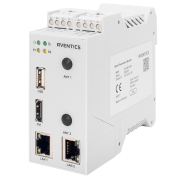 Digital transformation is the all-encompassing megatrend altering not only the daily life of consumers but also all aspects of engineering and automation. As an intelligent, robust and reliable technology, pneumatics is well prepared for the development and perfectly fits into the connected automation world.
Digital transformation is the all-encompassing megatrend altering not only the daily life of consumers but also all aspects of engineering and automation. As an intelligent, robust and reliable technology, pneumatics is well prepared for the development and perfectly fits into the connected automation world.
Convergence of information and operational technology
With the triumph of smartphones and the mobile internet, the Internet of Things (IoT) entered the consumer world roughly a decade ago. Since then an ever-growing number of household devices are wirelessly connected to the internet to make life easier and more convenient. If a failure of connection or function occurs, the consumer might be upset, but it usually does not result in a catastrophe.
This is a major difference to the Industrial Internet of Things (IIoT). An IIoT system has to be much more robust, as a machine failure has much more serious consequences compared to a failure of a toaster. IIoT marks the convergence of information technology (IT) and operational technology (OT) to run operations more smoothly and economically.
Industry 4.0 framework
As a middleware between digital transformation and via IIoT connected automation, the concept of Industry 4.0 tries to embrace the complete manufacturing model. Industry 4.0 is driven by the German government. This gives the concept an unusual backing that assures adoption at the business, consumer, and factory floor level, and propels it into a steep acceptance curve.
Furthermore, Industry 4.0 provides a framework of specifications. This not only includes details for the data structure, but also addresses many other parts of the machine, components, and product capabilities. Examples include standardized data sheets for easy maintenance (or replacement) of components, QR codes on products for traceability and identification, and other functions outside what would be considered control architectures.
Fast follower pneumatics
Electronic control devices and components have been the first to move into each of these technologies fast followed by pneumatics. Fieldbus manifolds are a perfect fit, as they already have communication interfaces which might be enhanced to include intelligence for local data processing of device analytics. This data can also be served up to the cloud for additional system analytics for actionable insights and remote accessibility.
In today’s market, pneumatic systems provide highly improved levels of intelligence, especially with increased PLC and PC use. The truth is that pneumatics technologies are essential for particular applications demanding simplicity and reliability. Emerson considers the information exchange and analytics as key to the three pillars of success: people, products, and processes.
When speaking of processes, digital transformation assures that the entire value flow can be analyzed with a focus on critical points and data, relevant products and systems that autonomously exchange data. This leads to each product being a part of the information chain. Data can then be processed by local hubs, accessed locally, and transferred by standards. The people portion comes in when the collection and analysis of data become easy to use and visualize, so that only relevant data are passed on to users, whereas errors, malfunctions and prognostics are reported directly to the right person.
Smart Pneumatics Monitor independent from machine controls
Companies like Emerson continue to push these technologies beyond the present envelope, providing higher levels of diagnostics, prognostics, accuracy, and safety. Emerson’s Smart Pneumatics Monitor (SPM) IoT gateway for example is used to analyze existing sensor signals to generate reliable status information. For example, when monitoring the wear of a shock absorber, the SPM breaks down the end switch signals to evaluate the cushioning sequence.
Based on the company’s application experience, algorithms are written to analyze this data internally and send the information either to defined people or to the parent MES or ERP systems via an OPC UA interface. Most important: the ease of use to start up the SPM. Users do not need PLC programming abilities. Through the drag-and-drop technology, the components to be monitored are combined and linked in the SPM. On request, the module monitors a variety of events, such as the current energy consumption or the degree of wear. Users are enabled to take measures for optimization early on, thereby meeting the requirements set out in the EU Energy Efficiency Directive but also minimizing unplanned system downtime.
The SPM provides reliable answers to important operational questions and sends status messages to defined employees and parent IT systems without detouring through a machine controller. This system minimizes the risk of machine downtime and substantially lowers operating costs across the board.
Knowing that IoT, IIoT, and Industry 4.0 are subconcepts of the superior digital transformation trend reduces the complexity. Although your equipment may operate in Industry 4.0 or IIoT, getting updated information for actionable insights may come through an IoT cloud-connected device.
